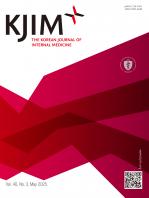|
Gastroenterology / Original Article
Efficacy and safety of sofosbuvir–velpatasvir and sofosbuvir–velpatasvir–voxilaprevir for hepatitis C in Korea: a Phase 3b study
Jeong Heo, Yoon Jun Kim, Sung Wook Lee, Youn-Jae Lee, Ki Tae Yoon, Kwan Soo Byun, Yong Jin Jung, Won Young Tak, Sook-Hyang Jeong, Kyung Min Kwon, Vithika Suri, Peiwen Wu, Byoung Kuk Jang, Byung Seok Lee, Ju-Yeon Cho, Jeong Won Jang, Soo Hyun Yang, Seung Woon Paik, Hyung Joon Kim, Jung Hyun Kwon, Neung Hwa Park, Ju Hyun Kim, In Hee Kim, Sang Hoon Ahn, Young-Suk Lim
Korean J Intern Med. 2023;38(4):504-513. Published online June 30, 2023
Background/Aims: Despite the availability of direct-acting antivirals (DAAs) for chronic hepatitis C virus (HCV) infection in Korea, need remains for pangenotypic regimens that can be used in the presence of hepatic impairment, comorbidities, or prior treatment failure. We investigated the efficacy an..
|
|
|
Review
Strategies for successful implementation and permanent maintenance of a rapid response system
Myung Jin Song, Yeon Joo Lee
Korean J Intern Med. 2021;36(5):1031-1039. Published online August 18, 2021
Rapid response systems (RRSs) have been introduced to intervene with patients experiencing non-code medical emergencies and operate widely around the world. An RRS has four components: an afferent limb, an efferent limb, quality improvement, and administration. A proper triggering system, a hospital..
|
|
|
Gastroenterology / Original Article
The quick sepsis-related organ failure score has limited value for predicting adverse outcomes in sepsis patients with liver cirrhosis
Jeongsuk Son, Sunhui Choi, Jin Won Huh, Chae-Man Lim, Younsuck Koh, Kang Mo Kim, Ju Hyun Shim, Young-Suk Lim, Sang-Bum Hong
Korean J Intern Med. 2020;35(4):861-872. Published online October 28, 2019
Background/Aims: The quick Sepsis-related Organ Failure Assessment (qSOFA) is a newly developed risk stratification tool, which has been presented along with a new sepsis definition, to classify infected patients outside of the intensive care unit (ICU). We evaluated the clinical usefulness of qSOFA..
|
|
|
Hemato-oncology / Original Article
Practice patterns of multidisciplinary team meetings in Korean cancer care and patient satisfaction with this approach
Chi Hoon Maeng, Hee Kyung Ahn, Sung Yong Oh, Seungtaek Lim, Bong-Seog Kim, Do Yeun Kim
Korean J Intern Med. 2020;35(1):205-214. Published online December 6, 2019
Background/Aims: The multidisciplinary team (MDT) approach is a cornerstone of clinical oncology. This study investigated the current state of MDT care, including patient satisfaction, in Korea.
Methods: We obtained the annual number of cancer patients who have received MDT care since 2014 from the..
|
|
|
Gastroenterology / Review
Non-alcoholic fatty liver disease and lifestyle modifications, focusing on physical activity
Min-Sun Kwak, Donghee Kim
Korean J Intern Med. 2018;33(1):64-74. Published online December 6, 2017
Non-alcoholic fatty liver disease (NAFLD) is the most common chronic liver disease, and the prevalence of non-alcoholic steatohepatitis (NASH) with fibrosis is increasing as the population with NAFLD ages. To date, lifestyle modifications including weight loss, increased physical activity, and dieta..
|
|
|
Hemato-oncology / Review
Optimal maintenance and consolidation therapy for multiple myeloma in actual clinical practice
Ho Sup Lee, Chang-Ki Min
Korean J Intern Med. 2016;31(5):809-819. Published online September 1, 2016
Multiple myeloma is an incurable malignant plasma cell-originating cancer. Although its treatment outcomes have improved with the use of glucocorticoids, alkylating drugs, and novel agents, including proteasome inhibitors (bortezomib and carfilzomib) and immunomodulatory drugs (thalidomide, lenalido..
|
|
|
Case Report
Esophageal Thermal Injury by Hot Adlay Tea
Hoon Go, Hyeon Woong Yang, Sung Hee Jung, Young A Park, Jung Yun Lee, Sae Hee Kim, Sin Hyung Lim
Korean J Intern Med. 2007;22(1):59-62. Published online March 31, 2007
Reversible thermal injury to the esophagus as the result of drinking hot liquids has been reported to generate alternating white and red linear mucosal bands, somewhat reminiscent of a candy cane. This phenomenon is associated with chest pain, dysphagia, odynophagia, and epigastric pain. He..
|
|
|
















